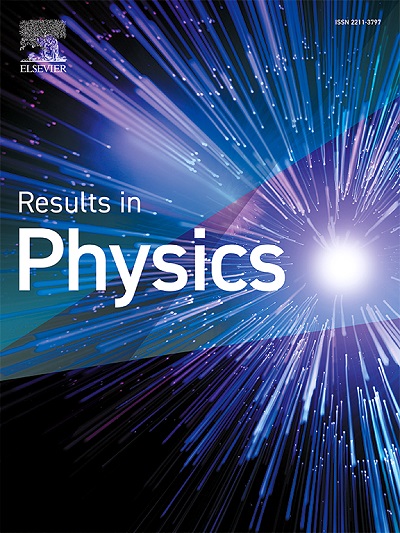Thermosolutal convection and entropy generation in hybrid nanofluids: FEM and ANN analysis of a magnetized wavy enclosure
IF 4.4
2区 物理与天体物理
Q2 MATERIALS SCIENCE, MULTIDISCIPLINARY
引用次数: 0
Abstract
This study investigates the thermosolutal convection and entropy generation in a magnetohydrodynamic (MHD) hybrid nanofluid-filled enclosure featuring wavy vertical walls and a centrally placed star-shaped cylinder. The problem addresses the critical need to optimize heat and mass transfer in engineering systems, such as thermal management, energy storage, and electronic cooling. A hybrid nanofluid composed of alumina () and copper () nanoparticles in water is analyzed using the Finite Element Method (FEM) via COMSOL Multiphysics, complemented by an Artificial Neural Network (ANN) model to predict the Nusselt number and validate results. Key findings reveal that increasing the Rayleigh number (Ra) from 103 to 105 enhances the average Nusselt number (NuAvg) by 16.27 % and total entropy generation (ETotal) by 93.53 %, driven by intensified buoyancy-driven convection. Conversely, a stronger magnetic field (Ha = 50) suppresses fluid motion, reducing (NuAvg) by 18.03 % and Sherwood number (ShAvg) by 10.83 %, while increasing ETotal by 80.83 % due to Lorentz forces. Hybrid nanoparticles (2 % volume fraction) improve (NuAvg) by 6.63 % compared to pure fluid, demonstrating their thermal enhancement potential. The Lewis number (Le) and buoyancy ratio (N) significantly influence mass transfer, with (ShAvg) rising by 41.60 % at (Le = 10) and 32.90 % at (N = 10). The ANN model achieves exceptional accuracy (R = 1, MSE = 2.47 × 10−9) in predicting thermal behavior, reducing computational effort. Novelty lies in the combined analysis of hybrid nanofluids, star-shaped geometry, and MHD effects using FEM-ANN integration a configuration unexplored in prior literature. This work provides actionable insights for designing energy-efficient systems with optimized entropy generation and enhanced thermal performance.
混合纳米流体中的热溶质对流和熵生成:磁化波浪形外壳的有限元和人工神经网络分析
本研究研究了磁流体动力学(MHD)混合纳米流体填充外壳中热溶质对流和熵的产生,该外壳具有波浪状垂直壁和中央放置的星形圆柱体。该问题解决了工程系统中优化热量和质量传递的关键需求,如热管理、能量存储和电子冷却。采用COMSOL Multiphysics软件对水中氧化铝(Al2O3)和铜(Cu)纳米颗粒组成的混合纳米流体进行了有限元分析,并辅以人工神经网络(ANN)模型对Nusselt数进行了预测和验证。结果表明,在浮力驱动对流的作用下,Rayleigh数(Ra)从103增加到105,平均努塞尔数(NuAvg)和总熵产(ETotal)分别增加了16.27%和93.53%。相反,更强的磁场(Ha = 50)抑制流体运动,使(NuAvg)减少18.03%,舍伍德数(ShAvg)减少10.83%,而由于洛伦兹力的作用,ETotal增加80.83%。与纯流体相比,混合纳米颗粒(体积分数为2%)的NuAvg提高了6.63%,证明了它们的热增强潜力。Lewis数(Le)和浮力比(N)显著影响传质,其中(ShAvg)在Le = 10时提高了41.60%,在N = 10时提高了32.90%。人工神经网络模型在预测热行为方面具有优异的准确性(R = 1, MSE = 2.47 × 10−9),减少了计算工作量。新颖之处在于混合纳米流体、星形几何和MHD效应的综合分析,使用FEM-ANN集成,这是先前文献中未探索的配置。这项工作为设计具有优化熵生成和增强热性能的节能系统提供了可行的见解。
本文章由计算机程序翻译,如有差异,请以英文原文为准。
求助全文
约1分钟内获得全文
求助全文
来源期刊

Results in Physics
MATERIALS SCIENCE, MULTIDISCIPLINARYPHYSIC-PHYSICS, MULTIDISCIPLINARY
CiteScore
8.70
自引率
9.40%
发文量
754
审稿时长
50 days
期刊介绍:
Results in Physics is an open access journal offering authors the opportunity to publish in all fundamental and interdisciplinary areas of physics, materials science, and applied physics. Papers of a theoretical, computational, and experimental nature are all welcome. Results in Physics accepts papers that are scientifically sound, technically correct and provide valuable new knowledge to the physics community. Topics such as three-dimensional flow and magnetohydrodynamics are not within the scope of Results in Physics.
Results in Physics welcomes three types of papers:
1. Full research papers
2. Microarticles: very short papers, no longer than two pages. They may consist of a single, but well-described piece of information, such as:
- Data and/or a plot plus a description
- Description of a new method or instrumentation
- Negative results
- Concept or design study
3. Letters to the Editor: Letters discussing a recent article published in Results in Physics are welcome. These are objective, constructive, or educational critiques of papers published in Results in Physics. Accepted letters will be sent to the author of the original paper for a response. Each letter and response is published together. Letters should be received within 8 weeks of the article''s publication. They should not exceed 750 words of text and 10 references.
 求助内容:
求助内容: 应助结果提醒方式:
应助结果提醒方式:


